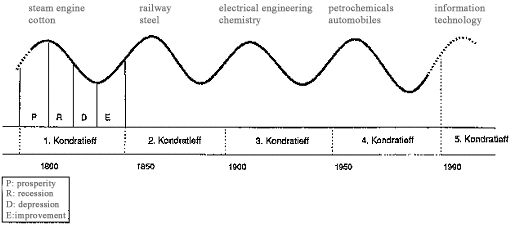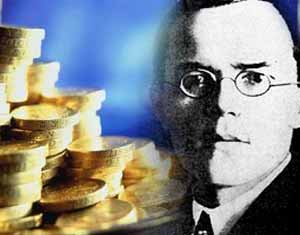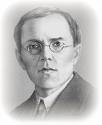Editor's Note
We bring to the attention of Global research readers a study by two prominent Russian economists on Kondratief's "Long Wave".
The Long Wave Theory of Nikolai Kondratiev's, first formulated in the 1920s, constitutes an important landmark in economic theory.
As to whether it is useful in understanding the current global economic crisis, however, is another matter.
The K cycle approach posits a regular long cycle. It tends, therefore, to ignore the deliberate process of market manipulation which characterizes the current financial crisis.
Michel Chossudovsky, Global Research, November 27, 2008
THE LONG WAVE THEORY IS REMEMBERED ONLY IN CASES OF COLLAPSE
The financial crisis that has broken out in the United States and lately encompassed the whole world requires adequate measures from the global community. But what action should be in this case considered adequate? To answer this question, we have first to identify the real underlying reasons that generated the crisis, and estimate its depth and length. Dogmatized liberal economists keep convincing us that in several months, or at least in a year or two, everything will "calm down", and the world will return to the development progress with Russia transcending to the innovation model of economy. Is that really so?
More than eighty years ago, prominent Russian economist, Prof. Nikolai D. Kondratiev described and theoretically substantiated the existence of grand (45-60 years) cycles of economic development, in which framework the global "reserve of major material values" are being replenished, i.e. the aggregate productive forces of the world community transcending to a higher level each cycle.
According to Kondratiev, every cycle has a rising and declining phase. The internal dynamic of the cycles (named K-cycles after him) and the principle of fluctuations is based on the mechanism of accumulation, concentration, dispersion, and devaluation of capital as a key factor of the development of the market (capitalist) economy.

Moreover, Kondratiev indicated that this cyclical regularity will exist as long as the capitalist mode of production will. "Every new phase of the cycle is predetermined with accumulation of factors of the preceding phase, and every new cycle is following the preceding one as naturally as one phase of each cycle after another. However, it has to be understood that every new cycle emerges in new particular historical conditions, on a new level of development of productive forces, and therefore is not a simple reiteration of the preceding cycle". [Not simple reiteration, but, basically, yes., according to Kondry’s objectivistic scheme. True only in a particular eco-financial system.]
Nikolai Kondratiev managed to study only two big cycles and a half, ceasing his research on the rising phase of the third one. He delivered his report already on the descending phase of the third cycle, in 1926, when the scale and length of this descending phase could not yet be assessed (so he predicted the Great Depression):
1. The rising phase – from late 1780s-early 1790s to 1810-1817.
The declining phase: from 1810-1817 till 1844-1851.
II. The rising phase: from 1844-1851 till 1870-1875.
The declining phase: from 1870-1875 till 1890-1896.
III. The rising phase: from 1890-1896 till 1914-1920.
Regrettably for international economic science, Nikolai Kondratiev fell into disgrace: in 1928, he lost the position of director of his research institute; in 1930, jailed for "anti-Soviet activities", and eventually executed. Orthodox Marxists, understanding history as a unidirectional linear process and forecasting the collapse of capitalism "next day", perceived his theory of gradual improvement of the capitalist order as a dangerous heresy. Other critics viewed regular declines of economy he described as sabotage of five-year economic plans (though Kondratiev took part in elaboration of the first five-year plan). As a result, Kondratiev's scientific heritage was blacked out for almost 60 years. Only in 1984, economist Stanislav Menshikov, a world-known scientist involved in forecasting under the auspices of the United Nations, a friend and co-author of John Kenneth Galbraith, rehabilitated Kondratiev's name in an article in "Communist" magazine.
In 1989, Mr. Menshikov and his wife published the most profound analysis of Kondratiev's theory under the title "Long Waves in Economy: When the Society Changes its Skin". One more prominent Russian author, Sergey Glazyev, contributed to Kondratiev's theory, providing structural analysis of the underlying change of "technological patterns (modes)".
Kondratiev's name was well known to Western economists. However, Stanislav Menshikov noticed a curious phenomenon: the interest to the theory of grand cycles rejuvenates usually in the declining phases – in 1920-1930s and in 1970-1980s, while in the rising phases, when global economy develops progressively and fluctuations, in accordance with Kondratiev's theory, are not very deep, the interest fades away.

A Long-Predicted Depression
Nikolai Kondratiev's forecasts were fully confirmed in the period of the Great Depression that coincided with the lower point of the third period's phase of decline. The further periodization is a subject of polemic. Researchers mainly divide into two groups, applying different approaches to the determination of cycles.
The first group, basing its analysis primarily on indices of real economy – amounts of production, dynamic of employment, investment activity and various structural proportions – believes that the declining phase of the third cycle finished with the beginning of the World War II. The rising phase of the fourth cycle, beginning during the war, continued till mid-1960s. The US dollar crisis and the collapse of the Bretton Woods system in 1968-71 became the critical point for transition to the declining phase, corresponding with the oil crisis and stagflation of the 1970s. "Reaganomics" in the United States and Margaret Thatcher's policy in Britain marked the transition to the next – fifth K-circle, its rising phase encompassing the second half of the 1980s and the 1990s.
As usual, in the end of the rising phase, in the so-called saturation zone, we are faced with such phenomena as decrease of the rate of return in the real sector and the relevant outflow of capitals into the sphere of financial speculation that generate first overheating of the stock market (late 1990s), and later the mortgage market (early 2000s). The researchers from the first group are convinced that cycles compress with intensification of scientific-technological progress: since 1940s, the length of a cycle has shrunk from 50-55 to 40-45 years.
The continuation of Kondratiev's regularity looks as follows:
The declining phase of the third cycle: from 1914-1920 (in the United States, from late 1920s) to 1936-1940.
IV. The rising phase: from 1936-1940 till 1966-1971.
The declining phase: from 1966-1971 till 1980-1985.
V. The rising phase: from 1980-1985 to 2000-2007.
The declining phase from 2000-2007 till approximately 2015-2025 (forecast);
VI. The rising phase from 2015-2025 till 2035-2045 (forecast).
The second group of researchers, relying rather on financial indices, i.e. the dynamics of the stock market and the dynamics of bonds return rates, extend the declining phase of the third cycle for the whole period of the World War II and the postwar reconstruction until 1949. Similarly to the first group, they locate the extreme point of the rising phase in early 1970s, but interpret the decline of that time as a "primary recession" followed by a plateau lasting till the beginning of the XXI century. They indicate that similar plateaus corresponded to the "bull trends" at the stock market in the preceding cycles, respectively in 1816-1835, 1864-1874, and 1921-1929. This group of researchers estimates the average duration of a cycle in 50 years, but the last cycle in their description is oddly protracted, exceeding 60 years.
Thus, according to the second group of analysts, Kondratiev's regularity is continued as follows:
The declining phase of the third cycle: from 1914-1920 till 1949.
IV. The rising phase: from 1950-70s, with a "primary recession" until 1982 followed by a plateau until 2000s.
The declining phase since early (mid –?) 2000s.
Thus, despite significant methodological difference in approach, both groups of analysts identify the 2000s as the beginning of a decline, i.e. a phase of depression.
The Current Crisis is Only the Beginning
At the face of decline, we expect a new burst of interest to Kondratiev's theory. Meanwhile, liberal monetarists whose view had been dominating in economic science for 25 years are discredited, and their efforts to interpret the current crisis as a temporary fluctuation in global economy, only reveal their economic ignorance. The experience of earlier K-cycles indicates that traditional anti-crisis measures are efficient only on the rising phase of the cycle, in the period of burgeoning growth when recessions are slight and transient on the background of the progressive development of global economy.
Gerhard Mensch, a scientist who studied similar processes during the declining phase of the 1970s, emphasized that in the conditions of deterioration of economic conjuncture, monetarist methods of resolving the problem are inefficient, as restrictive credit policy inevitably whips up consumer prices, while liberal pro-active policy favors speculative operations. It is quite natural that the strongly restrictive approach, chosen by the European Central Bank, results in rise of inflation, though five years ago, effects of the same policy was opposite. At the onset of the crisis, inflation in Europe did not exceed 2%, but by today, it has plummeted, despite the high level of the refinance rate, introduced by ECB. Meanwhile, the liberal policy, conducted until the recent period in the United States, beefed up stock market speculation and expansion of fictitious (inflated) capitals, stimulating speculative increase of prices in sectors of most marketable commodities – real estates, gold, oil, and food. This increase of pricing has no relation to amounts of production and saturation of the consumer demand.
Despite all efforts undertaken by ECB Chair Jean-Claude Trichet and Federal Reserve Chairman Ben Bernanke, positive changes are not achieved. The global economy has to pass through a period of "reloading", getting rid of the over-accumulated capital through its massive devaluation in the process of an inevitable and lengthy recession. Devaluation of the monetary capital is likely to proceed through a chain of financial crashes, triggering the third default of the US dollar (as it happened in 1920-1930s and in 1970s). Thus, the global economy is going to be shaken many times, and the current crisis is only a shot across the bow, warning of major events to arrive in the following years. The global economy is likely to reach the lowest point at the end of the declining phase of the
fifth K-cycle, in 2012-2015.
The crash of the US financial system may happen one or two years earlier in case the new U.S. President chooses a dogmatic approach to the current problems.





Aucun commentaire:
Enregistrer un commentaire